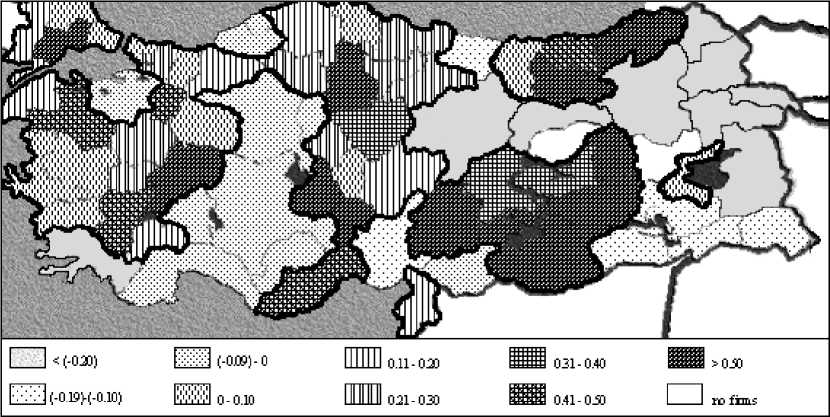way, but also the negative rates do form an axis, one from the South to the North and another
from the East to the interior parts.

Figure 6. Change in non-micro firm (>10 persons) population in Turkey, 1985-1992
As can be viewed from all these analyses, there seem to be five regions in which the firm
growth rates are positive. They are the Istanbul region (Istanbul, Tekirdag and Kocaeli), the
Blacksea region in the North (Kastamonu, Sinop and Samsun), the Izmir region in the West
(Izmir, Usak, Denizli), and the other two regions forming a geographically connected axis
from the Southeast of the country (starting from Sanliurfa, Adiyaman, Gaziantep, Hatay,
Kahramanmaras, Icel, Adana) through the interior parts (Nigde, Ankara) to the Northern
part, Blacksea (to Bolu).
Actually, those regions with positive firm growth rates are on the main highway network of
Turkey (see figure 7). The axis from the Southeast through inner parts to the North and the
Northwest is very clear. Another axis from the Southwest passing through the West is
connected to this axis either in the Northwest or in the interior part, where Ankara is the
intersection point. However, this just provide the structure, does not maintain any
information about the relations among the cities.
More intriguing information
1. AGRICULTURAL TRADE LIBERALIZATION UNDER NAFTA: REPORTING ON THE REPORT CARD2. The Impact of EU Accession in Romania: An Analysis of Regional Development Policy Effects by a Multiregional I-O Model
3. Job quality and labour market performance
4. An Efficient Secure Multimodal Biometric Fusion Using Palmprint and Face Image
5. An Estimated DSGE Model of the Indian Economy.
6. Commitment devices, opportunity windows, and institution building in Central Asia
7. The name is absent
8. sycnoιogιcaι spaces
9. An Empirical Analysis of the Curvature Factor of the Term Structure of Interest Rates
10. The value-added of primary schools: what is it really measuring?